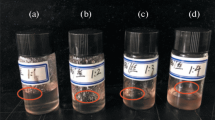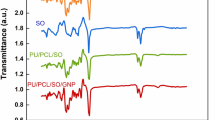Abstract
The hydrophobic nature of Poly L–Lactide (PLLA) limits its application in tissue engineering and drug delivery. In the present study, three methods were used to modify the hydrophobic properties of PLLA. In one method, hydrophilic PLLA fibers with open porous structure were produced by electrospinning method using water bath collector. In the second method, PLLA was made hydrophilic by the addition of hydrophilic polymers such as cellulose acetate (CA) and in the third method PLLA was blended with hydrophilic silk fibroin (SF) from Bombyx mori silk. The surface morphology of the electrospun PLLA based fibers was studied by scanning electron microscopy (SEM) and transmission electron microscopy (TEM). The pore size distribution and average fiber diameter of the PLLA based fibrous scaffolds were studied by capillary flow porometry. The contact angle measurements and water uptake test showed remarkable increase in hydrophilicity of the prepared PLLA based fibrous scaffolds. The herbal rich anti-tumor properties of turmeric in the form of curcumin were incorporated into PLLA based scaffolds and the presence of curcumin was identified by FT-Raman. The biocompatibility and anti-cancer activity of the PLLA based scaffolds and curcumin loaded PLLA based scaffolds were studied using mouse embryonic fibroblasts (NIH 3 T3) and human breast cancer (MCF 7) cell lines over a period of 24, 48 and 72 h by {3-(4,5-dimethylthiazole-2-yl)-2,5-diphenyl tetrazolium} (MTT) assay. These results confirmed the prepared electrospun fibrous scaffolds as a promising carrier for biomedical applications.






Similar content being viewed by others
References
Diba M, Kharaziha M, Fathi MH, Gholipourmalekabadi M, Samadikuchaksaraei A (2012) Preparation and characterization of polycaprolactone/forsterite nanocomposite porous scaffolds designed for bone tissue regeneration. Compos Sci Technol 72:716–723
Wang S, Zhang Y, Wang H, Yin G, Dong Z (2009) Fabrication and properties of the electrospun polylactide/silk fibroin-gelatin composite tubular scaffold. Biomacromolecules 10:2240–2244
Cui W, Cheng L, Li H, Zhou Y, Zhang Y, Chang J (2012) Preparation of hydrophilic poly (L-lactide) electrospun fibrous scaffolds modified with chitosan for enhanced cell biocompatibility. Polymer 53:2298–2305
Venugopal J, Ma LL, Yong T, Ramakrishna S (2005) In vitro study of smooth muscle cells on polycaprolactone and collagen nanofibrous matrices. Cell Biol Int 29:861–867
Kharaziha M, Fathi MH, Edris H (2003) Tunable cellular interactions and physical properties of nanofibrous PCL-forsterite:gelatin scaffold through sequential electrospinning. Compos Sci Technol 87:182–188
Agarwal S, Wendorff JH, Greiner A (2008) Use of electrospinning technique for biomedical applications. Polymer 49:5603–5621
Sohrabi A, Shaibani PM, Etayash H, Kaur K, Thundat T (2013) Sustained drug release and antibacterial activity of ampicillin incorporated poly (methyl methacrylate) – nylon6 core/shell nanofibers. Polymer 54:2699–2705
Goh Y, Shakir I, Hussain R (2013) Electrospun fibers for tissue engineering, drug delivery, and wound dressing. J Mater Sci 48:3027–3054
Supaphol P, Suwantong O, Sangsanoh P, Sowmya S, Jayakumar R, Nair SV (2012) Electrospinning of biocompatible polymers and their potentials in biomedical applications. Adv Polym Sci 246:213–240
Kim CH, Jung YH, Kim HY, Lee DR, Dharmaraj N, Choi KE (2006) Effect of collector temperature on the porous structure of electrospun fibers. Macromol Res 14:59–65
Casper CL, Stephens JS, Tassi NG, Chase DB, Rabolt JF (2004) Controlling surface morphology of electrospun polystyrene fibers: Effect of humidity and molecular weight in the electrospinning process. Macromolecules 37:573–578
Megelski S, Stephens JS, Chase DB, Rabolt JF (2002) Micro- and nanostructured surface morphology on electrospun polymer fibres. Macromolecules 35:8456–8466
Kidoaki S, Kwon IIK, Matsuda T (2005) Mesoscopic spatial designs of nano- and microfiber meshes for tissue-engineering matrix and scaffold based on newly devised multilayering and mixing electrospinning techniques. Biomaterials 26:37–46
Seo YA, Pant HR, Nirmala R, Lee JH, Song KG, Kim HY (2012) Fabrication of highly porous poly (έ-caprolactone) microfibers via electrospinning. J Porous Mater 19:217–223
Norman JJ, Desai TA (2006) Methods for fabrication of nanoscale topography for tissue engineering scaffolds. Ann Biomed Eng 34:89–101
Ramalingam N, Natarajan TS, Rajiv S (2014) Preparation and characterization of electrospun curcumin loaded poly (2-hydroxyethyl methacrylate) nanofiber-A biomaterial for multidrug resistant organisms. J Biomed Mater Res A. doi:10.1002/jbm.a.35138
Cheng AL, Hsu CH, Lin JK, Hsu MM, Ho YF, Shen TS, Ko JY, Lin JT, Lin BR, Ming-Shiang W, Yu HS, Jee SH, Chen GS, Chen TM, Chen CA, Lai MK, Pu YS, Pan MH, Wang YJ, Tsai CC, Hsieh CY (2001) Phase I clinical trial of curcumin, a chemopreventive agent, in patients with high-risk or pre-malignant lesions. Anticancer Res 21:2895–2900
Dhillon N, Aggarwal BB, Newman RA, Wolff RA, Kunnumakkara AB, Abbruzzese JL, Ng CS, Badmaev V, Kurzrock R (2008) Phase II trial of curcumin in patients with advanced pancreatic cancer. Clin Cancer Res 14:4491–4499
Priyadarsini KI, Maity DK, Naik GH, Kumar MS, Unnikrishnan MK, Satav JG, Mohan H (2003) Role of phenolic O:H and methylene hydrogen on the free radical reaction and antioxidant activity of curcumin. Free Radic Biol Med 35:475–484
Thangaraju E, Srinivasan NT, Kumar R, Sehgal PK, Rajiv S (2012) Fabrication of electrospun poly (L-lactide) and curcumin loaded poly (L-lactide) nanofibers for drug delivery. Fibers Polym 13:823–830
Elakkiya T, Malarvizhi G, Rajiv S, Natarajan TS (2013) Curcumin loaded electrospun Bombyxmori silk nanofibers for drug delivery. Polym Int 63:100–105
Nagiah N, Sivagnanam UT, Mohan R, Srinivasan NT, Sehgal PK (2012) Development and characterization of electrospun poly (propylene carbonate) ultrathin fibers as tissue engineering scaffolds. Adv Eng Mater 14:B138–B148
Frey MW, Li L (2007) Electrospinning and porosity measurements of Nylon-6/poly(ethylene oxide) blended nonwovens. J Eng Fibers Fabr 2:31–37
Rockwood DN, Preda RC, Yucel T, Wang X, Lovett ML, Kaplan DL (2011) Materials fabrication from Bombyx mori silk fibroin. Nat Protoc 6:1612–1631
Donsi F, Wang Y, Li J, Huang Q (2010) Preparation of curcumin sub-micrometer dispersions by high-pressure homogenization. J Agric Food Chem 58:2848–2853
Kizhakkayil J, Thayyullathi F, Chathoth S, Hago A, Patel M, Galadari S (2010) Modulation of curcumin-induced Akt phosphorylation and apoptosis by PI3K inhibitor in MCF-7 cells. Biochem Biophys Res Commun 394:476–481
Lau A, Villeneuve NF, Sun Z, Wong PK, Zhang DD (2008) Dual roles of Nrf2 in cancer. Pharmacol Res 58:262–270
Liu D, Chen Z (2013) The effect of curcumin on breast cancer cells. J Breast Cancer 16:133–137
Sa G, Das T (2008) Anticancer effects of curcumin: cycle of life and death. Cell Div 3:14
Prabaharan M, Jayakumar R, Nair SV (2012) Electrospun nanofibrous scaffolds-current status and prospectus in drug delivery. Adv Polym Sci 246:241–262
Acknowledgments
The authors acknowledge the Department of Science and Technology (DST) for financial assistance (Project No. SR/S1/PC-56/2009 (G) dated 12.07.2011). The instrumentation facility provided under FIST-DST and DRS-UGC to Department of Chemistry, Anna University, Chennai is gratefully acknowledged.
Author information
Authors and Affiliations
Corresponding authors
Rights and permissions
About this article
Cite this article
Thangaraju, E., Rajiv, S. & Natarajan, T.S. Comparison of preparation and characterization of water-bath collected porous poly L –lactide microfibers and cellulose/silk fibroin based poly L-lactide nanofibers for biomedical applications. J Polym Res 22, 24 (2015). https://doi.org/10.1007/s10965-015-0664-z
Received:
Accepted:
Published:
DOI: https://doi.org/10.1007/s10965-015-0664-z




